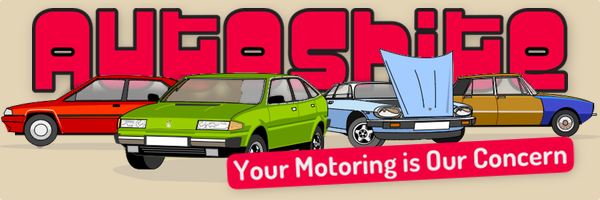-
Posts
526 -
Joined
-
Last visited
Content Type
Profiles
Forums
Events
Everything posted by Madman Of The People
-
Mitsubishi's situation is not much better in America. Most of their models are so old, the owner's manuals are handwritten on parchment! There's the aforementioned Outlander Sport, introduced way back in 2010 and facelifted three times since then. Then there's the "big" Outlander. The current model was launched in 2021 and is a rebadged Nissan Rogue/X-Trail. Last and most definitely least is the Mirage, launched in 2014 and facelifted twice since then. It is one of the cheapest, if not THE cheapest car you can buy in America today. And that's it. Three models, two very old and uncompetitive, plus one thinly disguised and woefully mediocre Nissan. I have no idea why Mitsubishi stays in America. They used to be the kings of finance for those with poor credit but the Koreans and Nissan stole that customer base from them a long time ago. And the Mirage is such a miserable turd of a car that you would have to be buying it for the warranty over choosing any decent three-year-old used car.
-
More fun facts: Elsewhere in the world, this is known as the Mitsubishi RVR. In the USA, it's called the Outlander Sport. Over the course of it's loooong production run (2010-Present) it's been facelifted THREE times! A new ASX was released for the European continent in September 2022, a rebadged second-generation Renault Captur. Pretty lazy rebadge, if you ask me. They're not even trying to disguise its origins!
-
I gather she's the local "good time" girl?
-
Y-Reg, according to the Escort in the left of the photo, so August 1982 at the earliest. Probably later than that, judging by the woman's coat in the background. Hillman Imp's G-Reg is from August 1968-July 1969. Trilby Man is the greatest hero in this photo! Looking at his steely determination behind the wheel, I suspect he's a WWII veteran who singlehandedly captured an entire German regiment! He arose every morning at the crack of dawn and shaved with a bayonet he took from a dead Wehrmacht officer he killed on the beach at Normandy. There is a village in France that still celebrates the day when he alone, separated from his fellow soldiers in the fog of battle, strode into their village and and sent the enemy fleeing in terror, liberating them from German occupation. Trilby man is not a slave to fashion. He will drive his trusty, faithful Imp for as long as is necessary (and as long as the MOT inspector will allow). I salute you, Trilby Man! The second greatest hero in this photo is whoever is driving that Volvo 164 in the background.
-
1960 Chrysler Imperial LeBaron. Imperial was it's own separate marque from 1955-75, spun off from Chrysler to compete with Cadillac and Lincoln. Although, to be fair, everyone still calls them Chrysler Imperials, since Chrysler had been using the Imperial name since 1926. In ascending order of price and prestige, 1960 Imperial models were Imperial Custom, Imperial Crown, Imperial LeBaron, and the very rare long-wheelbase Crown Imperial Limousine. During this time, Imperial was unique among Chrysler Corporation divisions in that its cars used body-on-frame construction with a separate chassis. Chrysler, Dodge, DeSoto, and Plymouth all made use of monocoque construction in 1960. But the 1960 Imperial's best party trick were automatic swiveling seats! Why don't cars have these today?
-
The banner on the side of the trailer provides a big clue. 1960 Plymouths for the Michigan State Police. These appear to be Fleet Specials, which were very basic, even below the Savoy (the base civilian model). Note these are all two-doors, which means these would have almost certainly been used as Highway Patrol cars. Highway Patrol cars are typically used for speed and traffic enforcement and, as such, aren't used to carry "perps" in the back seat.
-

Cars you didn't know existed until very recently.
Madman Of The People replied to philibusmo's topic in AutoShite
Miniature Mk I Porsche Cayenne? -
As a Chicago-area native and former Peugeot 505 owner, I would love to know which Illinois municipality was using a 505 as a police car in the 1980s. And, more to the point, WHY?
-

Cars you didn't know existed until very recently.
Madman Of The People replied to philibusmo's topic in AutoShite
The Ford Escort ZX2 sat below the Probe, both in size and price. As was the case with other 1990s North American Escorts, the chassis was taken from the Mazda 323/Australian Ford Laser. It used the same 2.0 Zetec as the Mondeo and Focus. The ZX2 was actually a belated replacement for the old North American Ford Escort EXP Coupe, discontinued a decade earlier. The 1999-2002 Mercury Cougar (exported to the UK as the Ford Cougar) was the quasi-replacement for the Probe. The front-drive Cougar was originally intended to become the Mk III Probe (the UK didn't get the Mk I Probe) but was hastily rebranded as a Mercury in the US just prior to launch, after Lincoln-Mercury dealers complained they were being starved of product. Ford threw them a bone by giving them this new "Cougar" as a consolation prize for Mercury losing the Capri, Tracer, Mystique, and the old rear-drive Cougar in rapid succession without being replaced. This new downsized Cougar was radically different from previous Cougars did not sell in the numbers anticipated. Traditional Cougar buyers wanted nothing to do with the new car. Side note: The Mk I Probe was intended to replace the Fox-body Ford Mustang in 1988. But as soon as Mustang fans heard the next iteration of their favourite car was going to be based on a front-wheel-drive Mazda 626 and there would be no V8 engine, they bombarded Ford's Dearborn H.Q. with "strongly worded" letters expressing their outrage. I'm willing to bet these letters contained plenty of anti-Japanese xenophobia, too! The letter-writing campaign achieved it's goal and Ford's bosses relented. With the new car's development already at an advanced stage, Ford had too much money invested to cancel it, so it was rebranded as the Ford Probe. Ford lost years of development time on the new Mustang and, as a result, the Fox-body Mustang had to soldier on until 1994, fifteen years after it had been launched! -
You've not heard of it? https://www.chick-fil-a.com/ Privately-owned fast-food chicken sandwich restaurant chain. https://en.wikipedia.org/wiki/Chick-fil-A The patriarch of the family who owns the company is a hardcore Bible-thumper (all restaurant locations are closed on Sundays) and he sparked a controversy several years ago for making some inflammatory anti-LGBTQ statements and is a supporter of right-wing Republican Party politicians. Many people and organisations refuse to eat there because of the owner's religious and political views. https://en.wikipedia.org/wiki/Chick-fil-A_and_LGBT_people
-
1980s General Motors A-Body "Clone-Cars" (Chevrolet Celebrity, Pontiac 6000, Oldsmobile Cutlass Ciera, Buick Century) Volvo 740/760
-
That's actually an Australian ad.
-
Larry Reed Sports Cars, Inc. 5208 Centinela Avenue, Los Angeles, CA 90045. This photo was taken on the corner of Centinela Avenue and LaCienega Boulevard. There is now a Chick-Fil-A fast food restaurant located on the site. I would post a Google Map link, but I must confess I don't know how. (Tried multiple times, but failed) Larry Reed also had two other locations. 9022 Wilshire Boulevard, Beverly Hills, CA 90211 is now a Lucid dealership and 19019 Hawthorne Boulevard, Torrance, CA 90503 is now a small shopping centre behind a McDonalds. It appears Larry either retired, sold up, or went out of business sometime around 1980. Here's Larry's 2011 obituary from the Los Angeles Times... https://www.legacy.com/us/obituaries/latimes/name/larry-reed-obituary?id=20948008 This dealer listing from the 1971 Southern California International Auto Show lists Larry Reed's Los Angeles location as selling Fiat, Saab, Simca, Sunbeam, Triumph, and Volvo. The Beverly Hills dealership sold Fiat, Rover, and Saab. The Torrance dealership sold Fiat, Rover, Saab, Triumph, and Volvo. https://www.thesamba.com/vw/archives/info/dealers/1971_southern_ca_auto_show_dealer_listing.pdf Larry Reed later sold Lancias at the Torrance and Beverly Hills dealerships during Lancia's short foray into the American market, lasting from 1975-82. The post-Fiat-takeover Lancia's sold in America were always sold through Fiat dealers and the ad below does not list the Los Angeles address, so I suspect that location may have shut down by the mid-1970s. And here we have a 1961 newspaper ad for Larry Reed's Torrance dealership (lower left corner). Seems old Larry dealt in all sorts, advertising "New and used Hillman, Healey, Borgward, Fiat, MG, Morris, Peugeot, Porsche, Renault, Simca, Sprite, Singer, Sunbeam, Triumph, Volkswagen, Volvo." I wish I could still buy that 1957 Renault Dauphine for $399. https://libarch.torranceca.gov/archivednewspapers/Press/1961 Jan -Jun/PDF/00000262.pdf Larry Reed in Beverly Hills pops up again in this February 1970 Rover/Land Rover USA-Canada dealer directory. https://www.lrfaq.org/Dealerships/Enfranchised_Dealers_Rover_US-Canada_Feb1970.pdf And Larry Reed in Torrance appears in this Volvo dealer directory from June 1966. https://volvo1800pictures.com/document/dealership/North_American_Volvo_Dealer_Directory_06_66.pdf Abarth Spyders. Ready to Race! Ad from the Los Angeles Times, Wednesday, 29 May 1968.
-
Interesting... US bumpers, but European headlamps and side repeaters. I wasn't aware Peugeot had sold leftover US-spec cars in Europe after they pulled out of America. The first 1992-spec models were in already in transit to America when Peugeot announced they were leaving. PMA slapped $6,000 rebates on all remaining cars to clear the existing inventories. I was once told by a former Canadian Peugeot owner that a batch of unsold Canadian-spec Peugeots were discovered parked in a storage lot outside the Sochaux factory sometime in 1993, which they had somehow forgotten about. Peugeot contacted their former dealer in Toronto, which had been the largest Peugeot dealer in Canada, and worked out a deal whereby the dealer agreed to buy the cars (heavily discounted, I'm sure) and they were sold with full factory warranty. These were the last new Peugeots sold in North America.
-
Yes, they did. I had one. Peugeot were already circling the drain when they launched the 405 in America and the car couldn't change that. The biggest complaints were that it was overpriced, underpowered, with tinny build quality and reliability that had no hope of matching the Japanese. Add to that a sparse dealer network that left large parts of the country inaccessible to anyone needing spares or service. Imagine having a breakdown in your 405, only to discover the nearest Peugeot dealer is 400 miles away! Peugeot's mainstay model in the US up until that point had been the 505 and a lot of Peugeot's American customers rejected the 405 because it was a smaller car that didn't offer the space, power, or the more substantial feel of the 505. Being smaller than the 505, these customers viewed the 405 as a downgrade. Peugeot never offered its smaller models in North America. It tried to market itself as a "Premium" brand in the US, more in line with BMW, Audi, or Saab. When it became all too clear the 405 wasn't going to reverse Peugeot's fortunes in America, they called it quits. The axe fell in August, 1991. Peugeot Motors of America, at the time based in New Jersey, were notified of the decision by a fax sent from Peugeot H.Q. in Paris.
-
Yes, this was a real magazine ad. The story was the Dauphine essentially disintegrated under American driving conditions, causing Renault's sales (and reputation) to collapse after just a few years. As a result, the R8 was met with suspicion, so when Renault improved it to make the R10, Renault were determined to rehabilitate their tattered reputation in the US. This ad was intended to address potential buyer's concerns. I can't imagine any car maker would dare to run such an ad today!
-

Cars you didn't know existed until very recently.
Madman Of The People replied to philibusmo's topic in AutoShite
Don't forget the 2006 Dodge Hornet concept, a B-segment MPV planed for release in 2010 but killed by the financial crisis and Chrysler's subsequent bankruptcy. https://en.wikipedia.org/wiki/Dodge_Hornet_(concept_car) -
Some more history nobody asked for: There was also a badge-engineered version called the Hupmobile Skylark. From Wikipedia: Desperate for a return to market strength, on February 8, 1938, Hupmobile acquired the production dies of the Gordon Buehrig-designed Cord 810, paying US$900,000 for the tooling. Hupmobile hoped using the striking Cord design in a lower-priced conventional car, called the Skylark, would return the company to financial health. Enthusiastic orders came in by the thousands, but production delays soured customer support. Lacking adequate production facilities, Hupmobile partnered with the ailing Graham-Paige Motor Co. to share the Cord dies. Hupmobile and Graham both sold similar models, all to be built at Graham-Paige's facilities. While each marque used its own power train, the Graham edition, called the Hollywood, differed from the Skylark in a few minor details. In 1939, deliveries of the Hupmobile Skylark finally began. Unfortunately, it had taken too many years to produce and most of the orders had been canceled. Production lasted only a couple of months, and only 319 Skylarks were produced. Hupmobile ceased production in late summer. Graham-Paige suspended production shortly after the last Hupmobile rolled off the line. Hupmobile Skylark
-
Correct. 1961 Fury had the chrome strip on the trunk. Belvedere and Savoy didn't.
-

10 (US Market) Diesel Cars That Time Forgot
Madman Of The People replied to Madman Of The People's topic in AutoShite
I should mention the reason Ford had access to BMW's inline six turbodiesel was because BMW already had the engine's emissions certified for its own 524TD, sold in the US with the requisite chunky battering ram bumpers. https://www.curbsideclassic.com/curbside-classics-european/curbside-classic-1985-bmw-524td-the-ultimate-diesel-driving-machine/ -

10 (US Market) Diesel Cars That Time Forgot
Madman Of The People replied to Madman Of The People's topic in AutoShite
A couple of really obscure diesel offerings that article overlooked was a pair of Lincolns offered in 1984-85. Believe it or not, you could buy a Lincoln Continental saloon or a Lincoln Mark VII coupe with a factory fitted BMW turbodiesel engine pinched from the contemporary 524TD. https://totallythatstupid.com/2020/08/05/1984-lincoln-continental-givenchy-turbo-diesel-when-is-a-bmw-not-a-bmw/ https://bringatrailer.com/listing/1984-lincoln-mark-vii/ -
Inspired by this discussion about US-market diesel cars from the late '70s and early'80s.... .... I happened to come across an article profiling 10 USA-market diesel cars from the so-called 'Malaise" era. Some diesels from this era were fairly popular. The ones on this list, however, weren't those. I wasn't even aware Renault made a diesel Fuego, let alone sold it in US! And I'm the biggest Euro-car nerd in America! Diesels that actually did sell well were the Volkswagen Rabbit (Golf Mk I) and Dasher (Passat Mk I), Mercedes Benz W123 and the W116 and W126 300 SD S-Classes, and a plethora of GM cars with the ill-fated Oldsmobile developed diesel V8. Here are 10 (US Market) Diesel Cars That Time Forgot..... https://www.autoweek.com/car-life/classic-cars/g36106078/diesel-cars-time-forgot/?source=nl&utm_source=nl_aut&utm_medium=email&date=120423&utm_campaign=nl33574480&user_email=c248eeb17740425fe3364440ef5e4debe3aed01fd2e1ed09d4c01f560b9aa75e&GID=c248eeb17740425fe3364440ef5e4debe3aed01fd2e1ed09d4c01f560b9aa75e&utm_term=TEST- NEW TEST - Sending List - AM 180D Clicks%2C NON AM 90D Opens%2C Both Subbed Last 30D
-

Cars you didn't know existed until very recently.
Madman Of The People replied to philibusmo's topic in AutoShite
For a brief period in the late 1970s and early 1980s, diesels experienced a boom in popularity in America. This accelerated in the wake of the second Arab oil embargo in 1979 combined with instability brought about by the overthrow of the Shah of Iran. America's short lived love affair with diesels coincided with Peugeot's most successful years in the US, peaking at just over 20,000 units sold in 1984. Nearly all Peugeots sold in America during this time were diesels. The same can be said for Mercedes-Benz, too. The Volkswagen Rabbit (Golf Mk I) diesel was a big seller, and nearly every manufacturer selling cars in the US offered diesels in their range. But Americans soon soured on diesels, thanks mostly to GM's catastrophically unreliable 5.7 litre diesel V8 tarnishing the reputation all diesels in the eyes of consumers. The return of cheap petrol by the mid-1980s hastened diesels fall from fashion . Those New York Peugeot taxis were part of an effort by the late 1970s to find a more efficient alternative to the aging Checker Marathon taxi, which was over 20 years old by this time. But is was the Chevrolet Caprice which became the preferred model of taxi companies going into the 1980s, no doubt due to taxi mechanics familiarity with the engines since the Checkers also used Chevrolet engines. The Caprice, however, was a lighter and more modern body as opposed to the 1950s era Checker body, which gave the Caprice an advantage in terms of fuel economy. The Caprice would remain an American taxi mainstay until the model went out of production in 1996, effectively ceding the taxi market to it's arch rival, the Ford Crown Victoria. -
This rusty Commodore is a 1950 model. Note how the badge on the wing does not touch the wheel arch.




